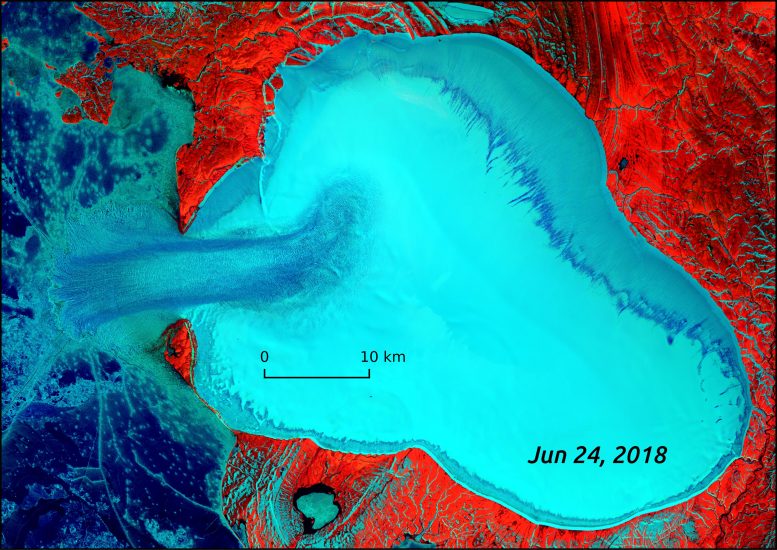
Landsat 8 false-color composite of Vavilov Ice Cap on June 24, 2018. Authors of a new study suspect the images show the first observation of a transition from a glacial surge to a longer-lasting flow called an ice stream. Credit: AGU/Geophysical Research Letters/Whyjay Zheng.
Scientists have captured the birth of a high-speed ice feature for the first time on top of a Russian glacier.
In a remote archipelago of the Russian Arctic, Vavilov Ice Cap had been moving at a glacial pace for decades. Then, in 2013, it suddenly started spewing ice into the sea, flowing in what scientists call a glacial surge. But a new study suggests this surge has now become something entirely different.
The authors of the new study published in the AGU journal Geophysical Research Letters have documented what they believe is the first observation of a transition from a glacial surge to a longer-lasting flow called an ice stream.
Ice streams and glacial surges were believed to be separate phenomena driven by different mechanisms. But if the authors of the new study are correct, glacial surges could instead be an early stage of an ice stream. If surging ice can form an ice stream on a glacier like Vavilov, then other ice caps might also experience similar rapid ice loss, said Whyjay Zheng, a Ph.D. candidate at Cornell University and the lead author of the new study.
“If that’s true, we probably have to revise our predictions for the impact of global sea level rise in the future,” he said.
From the time the surge at Vavilov began in 2013 until the spring of 2019, the ice cap lost 9.5 billion tons of ice, or 11 percent of the ice mass of the entire glacier basin.
Ice streams have been documented before in Greenland and Antarctica, where the ice sheets tend to be larger and their flow less constrained by bedrock features. To see an ice stream in a smaller ice cap like Vavilov would be unusual and perhaps unprecedented, according to the study’s authors. And as far as the researchers know, no one has observed one being formed.
“If you look at the satellite images, it seems like the entire west wing of the ice cap is just dumping into the sea,” Zheng said. “No one has ever seen this before.”
A glacier in transition
Zheng and other researchers at Cornell had been monitoring satellite images of this area since 2015, documenting the elevation change of the ice in a separate study. After the initial glacial surge, Zheng said, they decided to keep an eye on how the ice cap changed over time.
When the researchers analyzed the satellite images to see how the surge had progressed, they found that Vavilov was still collapsing. But by 2017, the way it was collapsing had changed.
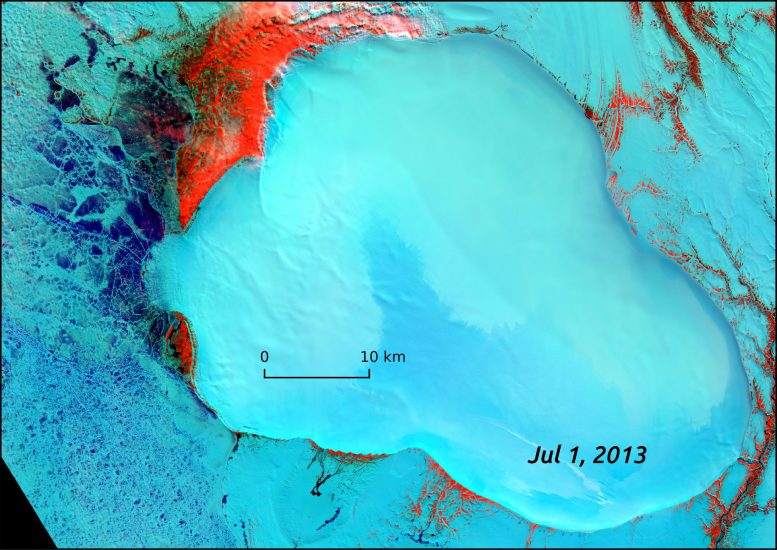
Landsat 8 false-color composites of Vavilov Ice Cap on July 1, 2013 (above) and June 24, 2018 (top of page). Shear margins began to form at the edges of the ice flow in 2016, appearing as dark, horizontal stripes in the image on the right.
Credit: AGU/Geophysical Research Letters/Whyjay Zheng.
From 2013 to 2016, Vavilov Ice Cap flowed in what appeared to be a typical glacial surge. Ice at the glacier’s edge where it met the Arctic Sea bulged outward in a wide fan shape, surging forward for about 10 kilometers at a maximum speed of 26 meters per day.
Then, in 2017, the ice fan stopped advancing. Instead, dark stripes appeared on the satellite images, indicating crevasses that had formed at the edges of the still fast-flowing ice.
Glacial surges transport massive amounts of ice in a short amount of time, typically a few months to several years. On the other hand, ice streams can maintain a constant, rapid flow for decades to centuries.
An ice stream is characterized by its long-lasting flow, but also by features called shear margins that form at the edges of the flowing ice. When the study’s authors saw these dark stripes, Zheng said, “We thought, wow, this is totally similar to an ice stream.”
This was the first clue that what the researchers were seeing was an ice stream forming from the initial glacial surge. To find further evidence, the study’s authors used the satellite data to calculate the elevation change and speed of the glacier over time.
The authors found that after the 2017 transition period, the shape of the glacier’s flow resembled an ice stream, indicated by its gentle slope and narrow width. The location of the fastest-flowing ice also changed after 2017, with the maximum speed shifting from the upper part of the glacier (typical of a surge) to the end point, or terminus, of the glacier (typical of a stream).
A matter of time
Not much is known about the formation and behavior of ice streams. Because of their remote locations, long-term observations of ice streams are scarce, according to the authors of the new study. While we know that ice streams tend to last for a long time—decades to hundreds of years—no one knows the average lifespan of these glacier features.
Denis Felikson, a cryospheric scientist at NASA Goddard Space Flight Center who was not involved in the research, said it will be interesting to watch Vavilov for the next several years to see whether the ice flow lasts long enough to classify as an ice stream. But, he said, he believes the new study shows strong evidence for a transition from a glacial surge to an ice stream.
“It’s really exciting that they found this and are documenting it, because we have very limited understanding of how these glacier behaviors work,” Felikson said. “There are some theories on how ice streams form, but to actually observe the possibility of that happening is unique and exciting.”
Reference: “The Possible Transition From Glacial Surge to Ice Stream on Vavilov Ice Cap” by Whyjay Zheng, Matthew E. Pritchard, Michael J. Willis and Leigh A. Stearns, 21 November 2019, Geophysical Research Letters.
DOI: 10.1029/2019GL084948


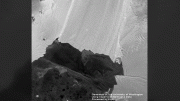
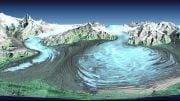
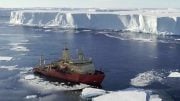


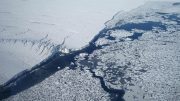
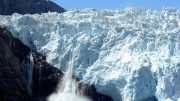
Be the first to comment on "Unprecedented Look at Ice Stream Formation on Remote Russian Glacier [Video]"